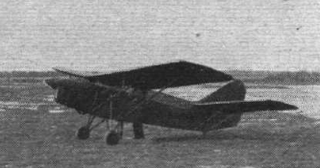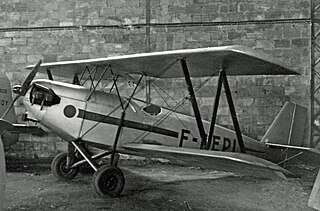Related Research Articles

The Starck AS-80 Holiday is a conventional two-seat, single-engine high-wing monoplane designed and built in France around 1950. It was sold in kit form but only a few were completed.

The Potez VIII was a French training aircraft which first flew in 1920. Originally it had a very unusual vertical inline engine and a four-wheeled undercarriage, though the production version was more conventional.
The Langlois JL.2 was a three-winged agricultural aircraft built in France in 1979. It failed to sell and only one was built.
The Landray GL.03 Pouss Pou was a small, pusher configuration tandem wing aircraft built in France in the early 1980s. Only one was completed, though it was much modified.
The Godbille JG.1B is a French light, two seat amateur built aircraft, dating from 1989. Only one was constructed.
The Jean-Montet Quasar 200 was a single-seat aerobatic competition aircraft designed and amateur-built in France in the early 1980s. Only one was completed; it won one aerobatic competition and was destroyed less than three years later.
The Barbaro RB-50 was a small, French, high wing single engine light aircraft, amateur built in the 1960s. Only one was completed.
The Chasle YC-10 Migrateur was a single seat sports aircraft built in France in the early 1980s. Only one was built and it flew for less than 30 hours.
The Lebouder Autoplane was a French amateur built modular roadable aircraft, with a car-like component that could be separated from its aeronautical parts. The sole Autoplane flew and drove successfully in the early 1970s.

The Payen Arbalète was a small, pusher configuration, experimental French tailless aircraft, designed by Nicolas Roland Payen, and first flown in 1965.
The Piel CP-10 was a post-war French sports aircraft in the Pou du Ciel tradition and was the first design from Claude Piel to fly.
The Piel CP-20 Pinocchio is a single engine French sport monoplane first flown in 1951. Only two were built but one was still flying over sixty years later.
The Piel CP-40 Donald is a French homebuilt, single engine, single seat, high wing aircraft. It was first flown in the early 1950s, though the last of the three examples completed did not fly until almost forty years later.
The Pottier P.60 Minacro is a homebuilt French single seat biplane designed for aerobatics. It first flew in the early 1990s; about six have been completed.
The Hennion was a two seat French training and touring aircraft, completed just before World War II began. It was flown again post-war and later fitted with a new engine; it survived into the early 1960s.

The SFCA Taupin was a French tandem-wing aircraft, designed to provide a simple, stable and safe aircraft able to take-off and land in small spaces.
The Lacroix-Trussant L.T.-51 Microplan was a French, low-powered, two seat amateur-built biplane. It flew just before the outbreak of World War II. After the war it was re-engined and flew until 1953.

The Charmier-Dupuy 10 was a French parasol-winged single seat light aircraft designed for low-cost flying. The sole example was first flown in 1924. Over a long career, it was fitted with three different engines and remained on the French register until after World War II.
The Mulot AM-20 was a Belgian single seat aerobatic trainer displayed at the 1937 Brussels Salon. Two were built.

The SCAL FB.40 was a French, side-by-side seat biplane trainer chosen in 1938 for widespread use in the Aviation Populaire programme. The Second World War prevented large scale production but at least two were restored post-war, one becoming a familiar rally participant.
References
- ↑ Roux December 1969, p. 6
- 1 2 3 Gaillard, Pierre (1990). Les Avions Francais de 1944 à 1964. Paris: Éditions EPA. p. 95. ISBN 2-85120-350-9.
- 1 2 3 "Payen Pa-47 "Plein Air"" . Retrieved 21 December 2014.
- ↑ Chillon, Jacques (25 June 2009). Fox Papa - Registre des avions Français amateur (2009 ed.). Brive: Ver Luisant. p. 52. ISBN 978-2-3555-1-066-3.